Inflight Magazine of Brussels Airlines
Welcome to the Inflight Magazine of Brussels Airlines
France’s grand canyon
As the heaving summer crowds begin to thin out, Neville Walker heads to Marseilles for a road trip from the Luberon to the Grand Canyon du Verdon
Images 4Corners, Alamy, Getty Images
Dial for France
Saignon to Colorado Provençal
 The stone steps are a little uneven and it’s no place for those with vertigo, but the climb to Rocher de Bellevue at Saignon rewards visitors with breathtaking views of the entire Luberon region, taking in the green massif of the Luberon itself, as well as Montagne de Lure, Mont Ventoux – notorious for testing the stamina of Tour de France cyclists in the intense summer heat – and the gentle vale between them. Far below, the regional capital, Apt, resembles a scale model of a Provençal market town.
The stone steps are a little uneven and it’s no place for those with vertigo, but the climb to Rocher de Bellevue at Saignon rewards visitors with breathtaking views of the entire Luberon region, taking in the green massif of the Luberon itself, as well as Montagne de Lure, Mont Ventoux – notorious for testing the stamina of Tour de France cyclists in the intense summer heat – and the gentle vale between them. Far below, the regional capital, Apt, resembles a scale model of a Provençal market town.
Made famous by Peter Mayle’s A Year in Provence, Luberon can often be overrun with visitors, even outside the high season of July and August. But Saignon is one of its lesser-known jewels, a rocky eyrie with a history dating back to pre-Roman times and all the shady corners and splashing fountains you could hope for. It’s an excellent place to start a journey across some of Provence’s less beaten paths.
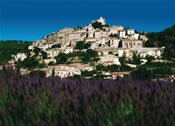 Catch your breath over Luberon lamb with thyme jus at the Auberge du Presbytère (Place de la Fontaine, tel. , rooms from €58), or snack on the sweet purple Muscat grapes that ripen in Luberon throughout September. Then take the winding minor road north, bypassing Apt to reach Rustrel on the Banon road. Rustrel is little more than a fleck on the map, but it does have a restored olive oil mill and the extraordinary Colorado Provençal (tel. ) – a weird wonderland of brilliantly coloured landscapes left behind by ochre quarrying. Beyond the Colorado, the D22 road continues east across the département boundary into the Alpes de Haute-Provence region.
Catch your breath over Luberon lamb with thyme jus at the Auberge du Presbytère (Place de la Fontaine, tel. , rooms from €58), or snack on the sweet purple Muscat grapes that ripen in Luberon throughout September. Then take the winding minor road north, bypassing Apt to reach Rustrel on the Banon road. Rustrel is little more than a fleck on the map, but it does have a restored olive oil mill and the extraordinary Colorado Provençal (tel. ) – a weird wonderland of brilliantly coloured landscapes left behind by ochre quarrying. Beyond the Colorado, the D22 road continues east across the département boundary into the Alpes de Haute-Provence region.
Pays de Forcalquier
Long before you reach it, the village of Simiane la Rotonde dominates the landscape, a ziggurat of stone houses climbing the hill to the château (tel. ), whose centrepiece is a spectacular domed medieval hall – la rotonde – that gives the village its name.
Sleepy Simiane is the first village in Pays de Forcalquier, a picture-perfect corner of deepest rural Provence, with ancient villages, a ruggedly beautiful landscape and some of the clearest skies in France. The village isn’t awash with hotels or restaurants and neither is its neighbour, Banon. However, you should linger in the latter long enough to buy some excellent chèvre de Banon goat’s cheese and to make the climb to the beautiful but tiny fortified medieval village above the modern town centre, where the houses arch over the street to form part of the fortifications.
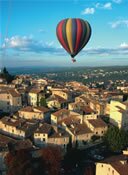 Forcalquier itself boasts a looming cathedral and a handful of places to stay: try Auberge de Charembeau (Route de Niozelles, tel. , www.charembeau.com, rooms from €53), located in an 18th-century farmhouse outside the town, or Hostellerie des Deux Lions (11 Place du Bourguet, tel. , www.lesdeuxlions.com, rooms from €55), a historic old coaching inn in the heart of the town. Dine in style amid the stone vaults at L’Estable (Place Bourguet, tel. ).
Forcalquier itself boasts a looming cathedral and a handful of places to stay: try Auberge de Charembeau (Route de Niozelles, tel. , www.charembeau.com, rooms from €53), located in an 18th-century farmhouse outside the town, or Hostellerie des Deux Lions (11 Place du Bourguet, tel. , www.lesdeuxlions.com, rooms from €55), a historic old coaching inn in the heart of the town. Dine in style amid the stone vaults at L’Estable (Place Bourguet, tel. ).
There are many good reasons to linger in Pays de Forcalquier. You can soar over lavender fields and hilltop villages in a hot-air balloon (France Montgolfière, tel. , www.france-balloons.com), take a close-up look at the big telescope at the Observatoire de Haute-Provence (St Michel l’Observatoire, tel. , www.obs-hp.fr) and take a stroll in the medieval and contemporary gardens at the former Benedictine priory of Notre-Dame de Salagon at Mane (tel. , www.musee-desalagon.com).
Manosque and the Valensole plateau
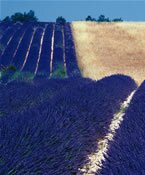 Manosque is a big town for rural Provence, with an atmospheric old quarter that buzzes with life on Saturdays when the market is in full swing. As the home of the soap and toiletries retailer l’Occitane en Provence, the town has helped spread the fame of Provence internationally, and you can arrange weekday tours of the factory through the tourist office (16 Place du Docteur Joubert, tel. , www.manosque-tourisme.com).
Manosque is a big town for rural Provence, with an atmospheric old quarter that buzzes with life on Saturdays when the market is in full swing. As the home of the soap and toiletries retailer l’Occitane en Provence, the town has helped spread the fame of Provence internationally, and you can arrange weekday tours of the factory through the tourist office (16 Place du Docteur Joubert, tel. , www.manosque-tourisme.com).
While you’re in Manosque, pick up some prize-winning AOC extra virgin olive oil from Le Moulin de l’Olivette (Place de l’Olivette, tel. , www.perso.orange.fr/moulinolivette). Stay at Le Pré St Michel (Route de Dauphin, Montée de la Mort d’Imbert, tel. , www.presaintmichel.com, rooms from €75), which has a pool and a good restaurant.
 Crossing the Durance river east of Manosque, the D6 road climbs to the Valensole plateau. This is classic lavender country, and although you won’t see the flowers in bloom in September, there are plenty of opportunities to buy lavender in Valensole: essential oils from Lavandes Angelvin distillery (Campagne Neuve, tel. , www.lavandesangelvin.site. voila.fr), paté à la lavande from Conserverie Artisanale Richaud et Fils (Zone Artisanale, tel. , www.etsrichaud.com) and lavender honey from Sarl Nevière (Route de Manosque, tel. , www.neviere.fr), where there’s also an interesting museum of bee-keeping.
Crossing the Durance river east of Manosque, the D6 road climbs to the Valensole plateau. This is classic lavender country, and although you won’t see the flowers in bloom in September, there are plenty of opportunities to buy lavender in Valensole: essential oils from Lavandes Angelvin distillery (Campagne Neuve, tel. , www.lavandesangelvin.site. voila.fr), paté à la lavande from Conserverie Artisanale Richaud et Fils (Zone Artisanale, tel. , www.etsrichaud.com) and lavender honey from Sarl Nevière (Route de Manosque, tel. , www.neviere.fr), where there’s also an interesting museum of bee-keeping.
Towards the Grand Canyon du Verdon
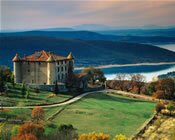 With its Roman remains, medieval gates and the vestiges of a 5th-century cathedral, the ancient town of Ríez, east of Valensole, is well worth a look. There’s also a local produce market twice a week, on Wednesdays and Saturdays. Unwind afterwards over lunch at Le Rempart (17 Rue du Marché, tel. ).
With its Roman remains, medieval gates and the vestiges of a 5th-century cathedral, the ancient town of Ríez, east of Valensole, is well worth a look. There’s also a local produce market twice a week, on Wednesdays and Saturdays. Unwind afterwards over lunch at Le Rempart (17 Rue du Marché, tel. ).
If you’re doing the Grand Canyon du Verdon in style, there’s no better base than Moustiers Sainte-Marie, 15km from Ríez. Here, Alain Ducasse’s Le Bastide de Moustiers (Chemin de Quinson, tel. , bastide-moustiers.com, rooms from €190) pulls out all the stops with its comfortable, traditionally-styled rooms, pretty gardens and excellent restaurant, where the locally sourced food is served on local Moustiers faïence ceramics. You can buy faïence in one of the ateliers in the village or admire it at Musée de la Faience (Espace Christiane Vivier, tel. , www.moustiers.fr).
Moustiers is a tourist honeypot, but it’s also a beautiful village in a spectacular setting beneath a cleft in the rock. If the crowds get too pressing, head for the chapel Notre-Dame de Beauvoir high above the village.
The canyon
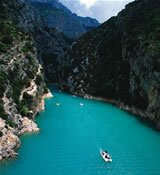 Nothing quite prepares you for the drama of Europe’s greatest canyon. Whether you approach it along the southern or northern rim, you won’t even see the Grand Canyon du Verdon properly until you’re already high above it.
Nothing quite prepares you for the drama of Europe’s greatest canyon. Whether you approach it along the southern or northern rim, you won’t even see the Grand Canyon du Verdon properly until you’re already high above it.
The Corniche Sublime along the southern side offers great vistas and multiple distractions for drivers. You can sleep on the edge of a 300m precipice at Hotel du Grand Canyon du Verdon (tel. , www.logis-de-france.fr, rooms from €60). The Route des Crêtes on the northern side is even more spectacular, with a series of belvederes giving awe-inspiring views down sheer rock faces to the milky, emerald-coloured river hundreds of metres below.
Maison des Gorges du Verdon (tel. , www.lapaludsurverdon.com) in La Palud is the best starting point for adventure-seekers, with plenty of information on walking, rafting, riding, canyoning, mountain biking and paragliding. It’s healthy, high-adrenaline stuff. Although it’s still Provence, it’s certainly a long way from the sedate charms of Peter Mayle.
FR>> Le Grand Canyon français
En partant du village de Saignon, grimpez jusqu’au sommet du Rocher de Bellevue, d’où vous bénéficierez d’un panorama sur la partie montagneuse du Tour de France. Dans ce petit joyau pas encore très connu du Lubéron, qui date de l’époque romaine, vous pourrez déguster l’agneau local, à l’Auberge du Presbytère, avant de vous remettre en route pour le Pays de Forcalquier.
Ici, vous trouverez une imposante cathédrale et des auberges-fermes du 18e siècle. Dînez avec style sous les voûtes en pierre de L’Estable, ensuite embarquezvous pour un tour en ballon, pour surplomber les champs de lavande de la région (www.france-montgolfiere.com).
Le samedi, ne ratez pas le marché de Manosque, l’une des plus grandes bourgades de la Provence rurale. C’est là également que se trouve le fabricant de produits de soins L’Occitane, dont on peut visiter la manufacture. Prélassez-vous au Pré St Michel, qui dispose d’une piscine et d’un bon restaurant.
La traversée de la rivière Durance vous conduira à l’ascension du plateau de Valensole, sur la route même du Grand Canyon du Verdon. En chemin, faites une halte dans la petite ville ancienne de Ríez, connue pour ses ruines romaines, ses portes médiévales et les vestiges de sa cathédrale du 5e siècle. Et pourquoi ne pas vous laisser tenter par une expérience inédite? Essayez Moustiers Sainte-Marie, pour La Bastide de Moustiers d’Alain Ducasse, ancienne propriété d’un maître-faïencier.
Puis, sans crier gare, vous tombez sur le théâtre du plus grand canyon d’Europe. Que vous arriviez depuis le pourtour sud ou nord, vous n’aurez pas une bonne vue de ce Grand Canyon du Verdon à moins de le surplomber. La Route des Crêtes sur la partie nord est une des manières les plus spectaculaires de l’approcher, plusieurs belvédères vous permettant d’apprécier ses points de vue époustouflants, depuis les faces rocheuses escarpées jusqu’à l’étendue d’eau bleu-émeraude, laiteuse, à des centaines de mètres en contrebas.
NL>> Franse Grand Canyon
Ga van Saignon naar de Rocher de Bellevue voor een fantastisch zicht op het bergachtige Ronde van Frankrijk-decor in dit minder bekende pareltje van de Luberon, dat teruggaat tot de Romeinse tijd. Geniet in de Auberge du Presbytère van lokale lamsbereidingen voor je naar het Pays de Forcalquier trekt.
Daar vind je een indrukwekkende kathedraal en 18de-eeuwse boerderijherbergen. Dineer in stijl onder de stenen gewelven van L’Estable en verken vervolgens de omliggende lavendelvelden per luchtballon (www.france-montgolfiere.com).
Mis op zaterdag de Provençaalse markt in Manosque niet. De stad is de thuisbasis van de exclusieve producent van toiletartikelen L’Occitane, waarvan je de fabriek kan bezoeken. Verblijf in de Pré St Michel, met zwembad én een goed restaurant.
Steek de rivier de Durance over en klim naar het plateau van Valensole op weg naar de Grand Canyon du Verdon. Stop onderweg bij het oude stadje Ríez voor de Romeinse ruïnes, middeleeuwse poorten en restanten van een 5de-eeuwse kathedraal. Zoek je een luxueuzere uitvalsbasis? Ga dan in Moustiers Sainte-Marie naar La Bastide de Moustiers van Alain Ducasse, waar de lokale faiencetegels indruk maken.
Maar het meest indrukwekkend is het uitzicht van het grootste ravijn in Europa. Of je nu de zuid- of noordroute neemt, je ziet de Grand Canyon du Verdon pas echt als je helemaal boven bent. De noordelijke Route des Crêtes is het spectaculairst, met een aantal belvédères die een adembenemend zicht bieden in de steile kloof, op de kolkende, smaragdgroene rivier honderden meters lager.
Leave a Reply
